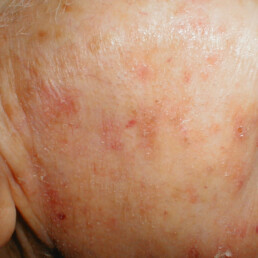Actinic Keratoses (AKs) are dry, scaly, rough-textured patches that form on the outermost layer of the skin after years of exposure to ultraviolet (UV) light, such as sunlight.
These lesions typically range in color from skin-toned to reddish brown and in size from that of a pinhead to larger than a quarter. AKs are considered the earliest stage in the development of skin cancer and have the potential to progress to squamous cell carcinoma. Years of sun exposure cause AKs to develop. There are several treatment options for AKs, including cryosurgery (freezing), surgical excision, curettage (scraping) with or without electrosurgery (heat generated by an electric current) and topical (applied to the skin) medications. Lasers, chemical peels, dermabrasion, and photodynamic therapy may also be used.
Want to learn more about clinical studies and the newly approved medications? We always offer a complimentary one-on-one consultation with one of our dermatologists.

